Thanks to some of our previous deep culinary explorations here on Arousing Appetites, we’ve encountered some prevailing trends in the world’s history.
Introducing the Spanish conquistadors into the picture, for example, generally spelled bad news for the land’s indigenous populations. We’ve seen it certainly be the case both in Jamaica and in Haiti.
Sometimes, amid all the historical despair, however, it’s nice to find a sort of “silver lining” like there is with anticuchos. Because without the conquistador influence, these exquisite and exotic Peruvian beef kabobs would not be around today.
And so the plot thickens.

Anticuchos and the Influence of the Spanish Conquistadors
In a way, anticuchos (among other recipes) technically remains one of the most durable artifacts of South American pre-conquistador times, albeit indirectly.
During the Incan Empire between the 13th and 16th centuries, the Incans had domesticated two animals: llamas and alpacas. In addition to their wool, both animals – though particularly the llama – held great value in Incan society as they were thought of as living representatives of sacred Incan gods. The royal symbol for the entire empire, for example, was a white llama adorned in a red cloth and with golden earrings.
Not wanting to anger the gods, it was mandated that every part of the animal either be immediately consumed, preserved or used in another way following the animal’s death. For the shepherd’s that oversaw and maintained flocks of these alpaca and llama, failure to do so could even be punishable by death.
Various food products were made from the meat and insides of these animals. For example, the earliest form of our modern day jerky, the Andean charqui, was made from strips of freeze dried llama meat.
With the llama’s heart, the Incans would make seasoned kabobs that can be considered the ancestor to the modern version of anticuchos.
You May Also Like…
If you love this recipe, you might also like our other recipe for grilled ground beef and pork kebabs (cevapi), or try shrimp skewers (Acaraje with Vatapa). If you love Peruvian food in general, definitely check out a Peruvian fried rice recipe with a Cantonese flair.
Enter the Conquistadors
By 1572, the Spaniards had won a decades-long conflict with the Incans to colonize and create the new Viceroyalty of Peru. By this point, the Spaniards had completely devastated the former Empire and decimated their population. It was estimated, for example, that for every 58 Incans that lived during the conflict’s 1521 beginning, only 1 remained by its end.
With the new Viceroyalty established, Spaniards flooded into the new lands and triggered an immense “cultural overhaul” wherein the local culture was reshaped thanks to heavy Spanish influences.
The subsequent “Spanification” and evolution of anticuchos can serve as a nice microcosm for the greater cultural evolution.
The Evolution of Anticuchos
Prior to the Spaniards, the Incans would season their version of anticuchos (this one with llama hearts, remember) only with some herbs and a little bit of pepper.
During the time of the Viceroyalty, the recipe underwent some drastic changes. For one, the Spaniards replaced llama with beef in much of the everyday diet, and they imported new ingredients in from the mainland like cumin, garlic and vinegar as well. For anticuchos, this meant a transition from the llama heart to the beef heart and a whole slew of added ingredients to the seasoning.
The influence, however, did not stop with the Spaniards. Along the coastlines, Spaniards built haciendas and plantations to cultivate profitable sugar cane and cotton crops, and much of the labor was supplied by the lucrative African slave trade at the time.
According to the National Library of Peru’s archives, the Spaniards originally considered the organs and innards of the animal to be garbage and would relegate this “garbage” to their slaves to eat. The slave populations – a mixture of Africans and surviving Incans – reverted to heavy marinade mixes in order to make these organs edible and agreeable to the palate. As most of the slaves came from West African nations with a known penchant for peppers, their versions of anticuchos began including pastes made from indigenous chilis. All together, these beef kabobs developed into a whirlwind and delicious combination of Andean, Spanish and African influences that grew wildly popular among the poorer demographics.
Not to miss out on a delicious and suddenly-chic recipe, the Spanish elite soon too began eating these marinated beef hearts and dubbed them anticuchos. The name is technically a “Spanified” combination of longstanding Quechua words anti (Andes) and kuchu (cut), although the Spanish version has stuck thanks to a writing system that the Incan language sorely lacked. It’s helpful to note that, because of this writing system, many credit the creation of anticuchos to this 17th century conquistador period even despite the evidence of the recipe’s earlier existence.
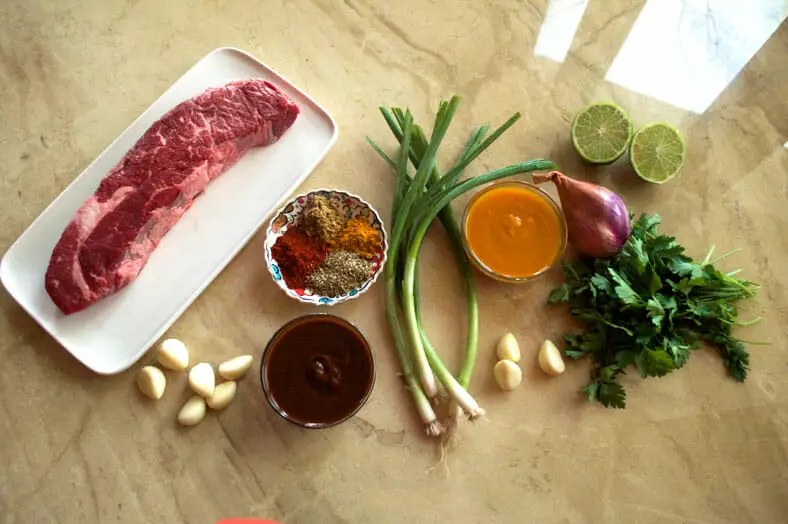
About the Recipe
Of course there’s the heart, but the key to the anticuchos recipe lies in the marinade.
At the base of the modern recipe is your aji panca. The aji panca is a type of chili pepper indigenous to Peru and is one frequently used in the cuisine. It is a mild pepper with a dark red color that, when cooked, gives off a combination of both smoky and fruity in its flavor profile.
Most of the time, you can find aji panca already in a paste form, although you can also find dried versions of the pepper if you feel so inclined. Since a marinade is the end-goal, though, the paste is the most convenient route. Just be mindful to find a paste without unnecessary additives or preservatives.
In addition to the aji panca, your marinade should have some combination of olive oil, garlic, cumin, some vinegar and/or all of the above. Additional herbs like oregano can be added as well, but the base for the marinade should have the above ingredients featured first.

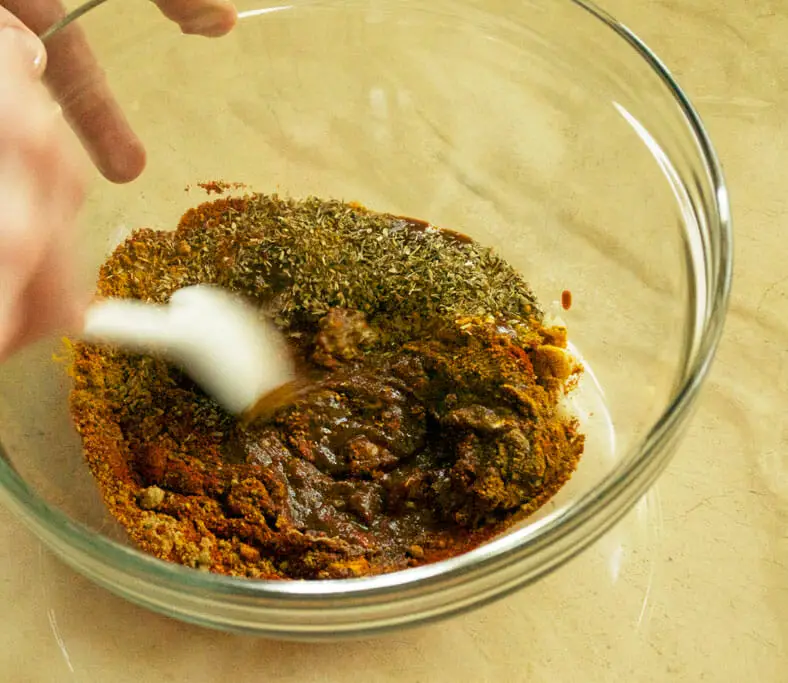
Once your marinade has been mixed together, you’ll want to place your meat directly into it. Especially if you’re going to use hearts, it’s important that your marinade get nicely worked into the meat. For us, we found this to mean that it’s easiest and most effective to massage the marinade into the meat with our hands, but we’ll leave that more as a suggestion than a prescription. Let the meat sit in the marinade for at least an hour (though preferably longer) before moving onto cooking.
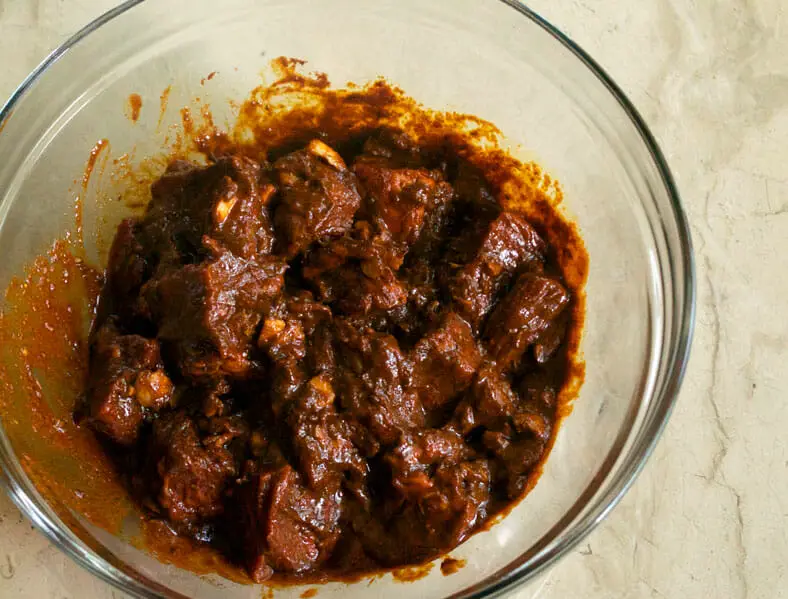
While your anticuchos are marinating, you can use the time to create other sauces to accompany the dish. You’ll generally want to keep the marinade for the anticuchos itself fairly mild so that it can be enjoyed by people of all sorts of spicy tolerances, but it’s helpful to have additional aji sauces prepared for those looking to take it up a notch. To make an aji sauce (or several), you’ll want to follow a similar process to making the marinade, although we might suggest blending or pureeing your ingredients to get a smoother “saucier” texture.
Finally, we come to the cooking of the anticuchos themselves. The cooking doesn’t take all too long, but you’ll want to have a grill going with a very healthy flame ready to go. A medium-high heat like ~350 degrees Fahrenheit will definitely do the job.
Take your pieces of meat and put them onto a skewer, then lay directly onto the grill. Depending on your preferred level of doneness, you’ll want to grill for at least 3-5 minutes on each side. If you’re going to use heart, we would advise you to err on the side of caution, but that’s entirely up to you. Properly cooking your anticuchos would imply, though, that they come off the grill with a nice healthy char on parts of the meat.

Once off the grill, your anticuchos serve as a fantastic snack or accompaniment to a larger dish. They go particularly well with potatoes, sausages, choripanes and salads.
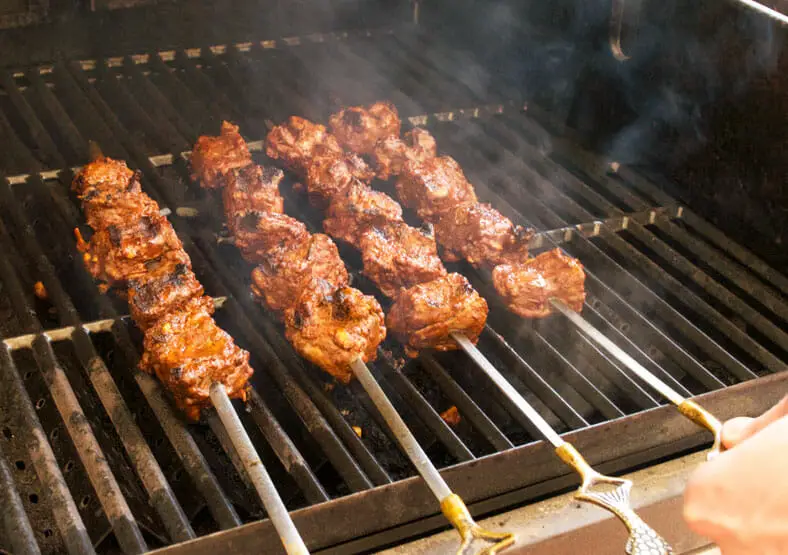
Our Take on the Recipe
In order to make this recipe perhaps a bit more palatable to a greater audience, we made our version with beef chuck roast instead of heart. Technically, this means that we made brochetas and not true anticuchos, but it is a change that we’re okay with for this purpose.
Using this recipe as our original reference, we did make a few adjustments and tweaks to our version. For one, we increased the amounts of garlic and cumin into the recipe while reducing the amount of vinegar by a tablespoon. Call this a personal preference if you will, but we just found 1/4 cup of vinegar to be too overpowering to the overall flavors.
In addition to the proportion adjustment, we added paprika and turmeric. These aren’t traditional ingredients to anticuchos, but they had a delicious effect on the grilled chuck roast.
For the aji amarillo sauce, we did a bit of experimentation here as well. We added shallots, more garlic and a touch of freshly squeezed lime juice to both of our sauces. For one, though, we added an extra handful of spring onions and cilantro, which turned an otherwise yellow aji amarillo sauce into an aesthetically appealing green. Both traditional yellow and green sauces packed a powerful bite and worked very well with the meat, so the adjustment proved to be more for presentation than for function.
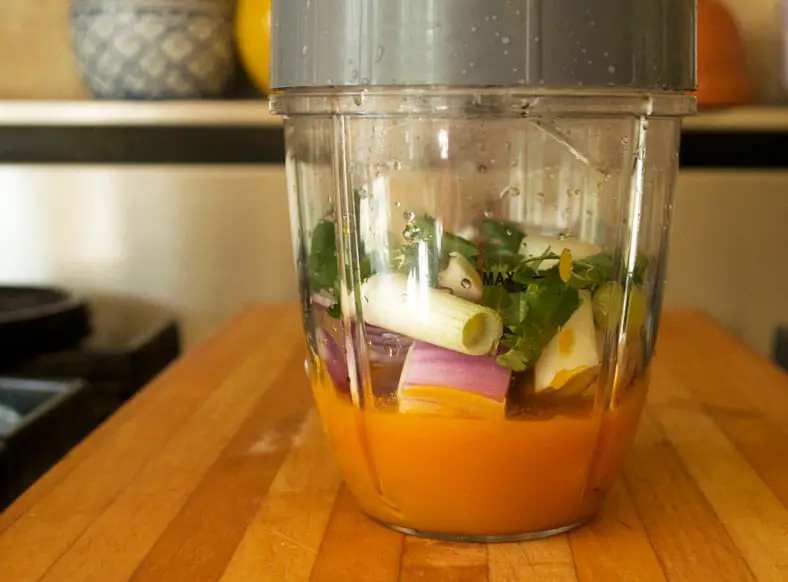
Other than that, making anticuchos (or in our case, brochetas) is incredibly simple, super delicious and also pretty healthy as well. Of course, that’s until the pisco sours make their way onto the scene.
Enjoy!
How do you prepare your anticuchos? Comment below!

Food styled by: Phil Roepers

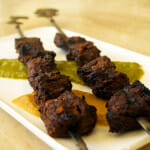
Anticuchos
- Total Time: 1 hour 23 minutes
- Yield: 4 people 1x
Description
Anticuchos with red wine vinegar and dry oregano.
Ingredients
- 1 pound of beef (we used chuck roast instead of heart), cut into 1-inch cubes
Marinade
- ½ cup ají panca paste
- ¼ cup olive oil
- 6 garlic cloves, minced
- 1 tablespoon red wine vinegar
- 2 teaspoons dry oregano
- 2 teaspoons ground cumin
- 2 teaspoons smoked paprika
- 1 teaspoon turmeric
- 2 teaspoons sea salt
- 1 teaspoon freshly ground black pepper
Aji Amarillo Salsa
- ½ cup ají amarillo paste
- 3 bunches of spring onions, roughly chopped
- ¼ cup fresh cilantro, roughly chopped
- 3 garlic cloves, roughly chopped
- 1–2 shallots, roughly chopped
- 1 lime, juiced
- 1 teaspoon sea salt
Instructions
Stage 1 – Create Anticuchos Marinade
- In a large mixing bowl, start by adding your aji panca paste and garlic cloves together. Mix well
- Next, add your oregano, cumin, paprika, turmeric, sea salt and black pepper. The marinade will temporarily thicken as you stir the spices through the rest of the paste
- Add your olive oil and vinegar and stir thoroughly to complete the marinade
- Once the marinade is done, add your pieces of beef to the marinade. Toss the meat well through the marinade to ensure that each piece is well coated. Don’t be afraid to use your hands here to get the job done
- With your anticuchos marinated, set aside and refrigerate for at least 1 hour. The more time you allow it to marinade, the better, but 1 hour should be the minimum
Stage 2 – Create Aji Amarillo Salsa
- In a blender or food processor (on Amazon), combine your aji amarillo paste, spring onions, cilantro, garlic, shallots and lime juice
- Blend together until you get a smooth, saucy consistency. Taste and season with extra salt as needed, but then set your salsa aside
Stage 3 – Grill Your Anticuchos
- Take your anticuchos out of the fridge and allow to come to room temperature
- While they are, preheat your grill. Try to create a temperate, medium flame or heat on which to cook your anticuchos
- Once the flame is ready and your meat has come to room temperature, place your meat on skewers and then lay directly on the grill
- Grill the meat for 3-4 minutes on each side, depending on your preferred level of doneness
- Once the anticuchos are grilled and cooked, set on a plate alongside aji amarillo salsa, and enjoy!
- Prep Time: 1 hour, 15 mins
- Cook Time: 8 mins
- Category: Meat Dishes
- Cuisine: Peruvian
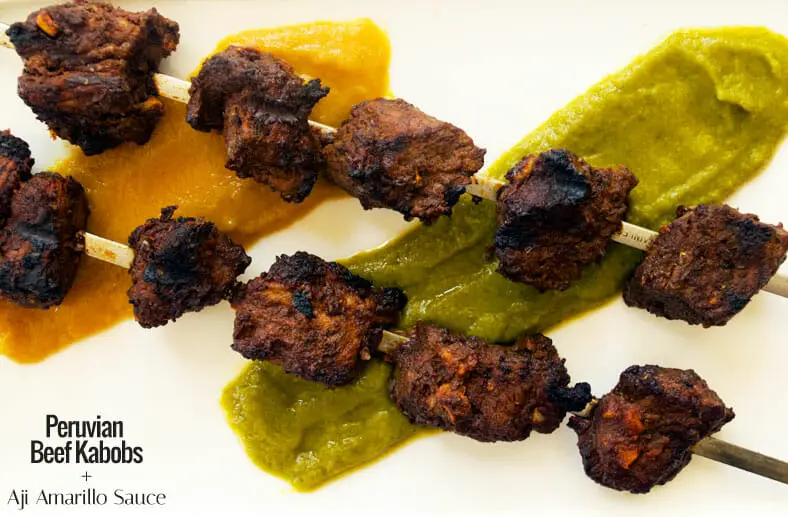

Looks like the perfect recipe to try for summer grilling. Just looking at the ingredients in the marinade I can already taste how delicious these kabobs would be!
Indeed it is! They were so tasty, and their perfectness for the summer is exactly why we decided to feature this recipe from Peru 🙂